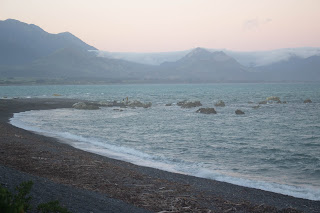Update:
We were all very sad to leave Wellington on the third morning. We boarded the Interislander ferry and endured a three hour thirty minute ferry ride to the South Island. The view was pretty from the harbor of Wellington, but arriving at Picton was definitely the most exciting part of the entire trip. Once in Picton, we met our bus driver, Pania, who will be accompanying us for the remainder of our study abroad.
Picton is an adorable little town full of coffee shops, boutiques, ice cream stands, and even more breath-taking ocean views. Our first item on the itinerary was sea kayaking. We were headed to Kaipupu, a wildlife sanctuary blocked off from the mainland so only kayakers could reach it. Our kayak guides, Merlin and Chris, lead us up a steep twenty minute hike (they claimed it was a "short walk, not steep or a hike at all" and they lied!). The lookout on the top was totally worth the effort! The sea was blue, the sun warm and yellow, the breeze fresh and clean... I definitely wouldn't mind living near here either! As we walked back down to our kayaks, we passed multiple nesting boxes for penguins! They were unfortunately empty, but New Zealand penguin chicks actually head back to their old nesting boxes and kick out their parents. Penguins in the box have to compete for the space with their mature offspring and kiwis, who also try to claim the safety of the boxes. We also tried three different types of plants on our descent: kawakawa, which is used to make tea; a vine that tasted like watery green beans; and another leaf that made our mouths go numb, which the Maori used as painkiller for dressing wounds.
After the arduous descent, we jumped into the ocean for a nice cool-off, then returned back to the mainland. We headed to our hostel, which looked more like a bed and breakfast than a youth hostel. We found dinner at an excellent little fish and chips shop, ate ice cream on the beach, and watched the sunset.
The next day, we unfortunately left the town of Picton. We had the most delicious hot pies for breakfast from the Bakkerij next door, who are a world-famous bakery, and rightfully so! We boarded the bus and drove along the coast for about an hour. We stopped at Pelorus Bridge for lunch and built little rock sculptures along the river. Photographing our rock sculptures and bridges made for a really fun break from driving. Kim led an interesting discussion on liminal spaces, which are transitions between two significant states. We mark liminal times of our lives with ceremonies and physical markings, We ate lunch on the bus and continued along Highway 1. New Zealand has seals too! Our group took a scenic detour and climbed around rocks with a seal friend. Soon after, we arrived in Kaikoura.
The Marae
Kaikoura is another small seaside town, similar to Picton. We are staying on the Takahanga Marae, which is comparable to a Native American reservation for a Maori tribe. The Maori have been on this land for hundreds of years, and it is a registered preserved historical site. The New Zealand government works much more closely with Maori people to respect their culture using legislature, and Maori is one of the national languages of New Zealand. These people have such an interesting history, and we were lucky enough to experience their welcoming ceremony.
For the ceremony, a mature or older woman (Kim, for our group) lead the pack with the younger women in age order behind her. Ian led the men, also in age order. In the olden times, the women would proceed the tribal procession to indicate that the newcomers were not coming for war. The warriors, or the young men, were in the back and could not fight from the distance. We entered through a tunnel made of whale bone and walked up the swirl-patterned path to the Wharenui, the sacred meetinghouse where we'd be sleeping for two nights. It is forbidden to wear shoes inside the Wharenui. We sat with the men on the front row, our BGSU group facing the iwi (tribe) who would be welcoming us. They said some words in Maori, which is a very melodious and flowing language with few hard consonants or breaks between phrases. They did a chant/song to acknowledge us and the ancestry that we carry with us, then we stood and sang a song back to them (Ay Ziggy Zoomba, our fight song). They took us out of the Wharenui and shared food with us, completing the official welcome.
We explored the Marae a bit, and had a really cool conversation with a woman named Mari who went to a Maori school on the North Island. Due to cultural reasons, we are not allowed to take pictures of the Wharenui, but we were given permission to photograph the grounds. The sunset filtered through the flowers and the greenery, and it made me really happy New Zealand is currently in the midst of a gorgeous summer! There is also a beach nearby, peppered with a mix of grey and white stones. The ocean looks particularly blue grey here, and the colors are unlike the combination you'd find on an American beach.
My Biggest Impression
Takahanga is a wonderful place. The aspect that made the biggest impression on me, however, was the focus on connection. The Marae is built to foster a spiritual connection to one's ancestry and one's past, thus recording one's sense of self and one's culture in every notch of every carved wooden pillar. They also have such a strong connection to one another. They share life on this Marae, and that strengthens their iwi daily. Every thing has a deeper connection to something else, and their sculptures and landscapes honor every single connection.







No comments:
Post a Comment